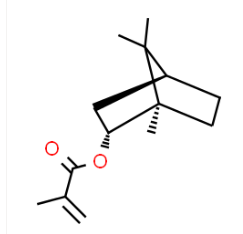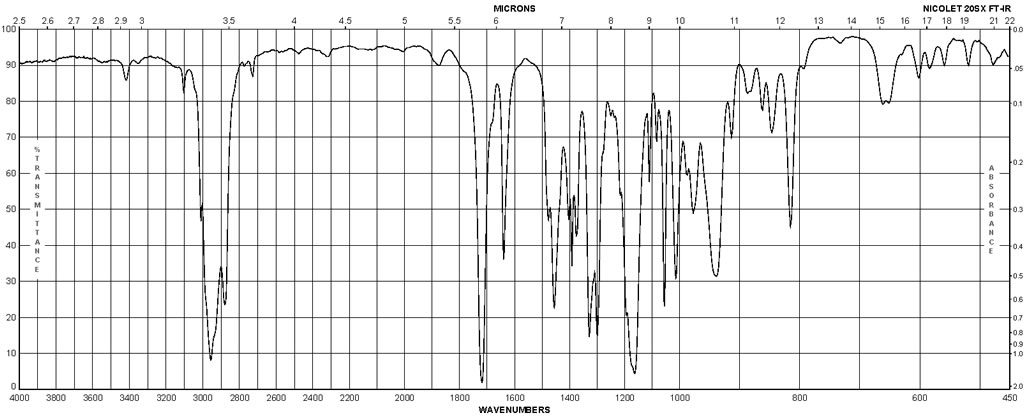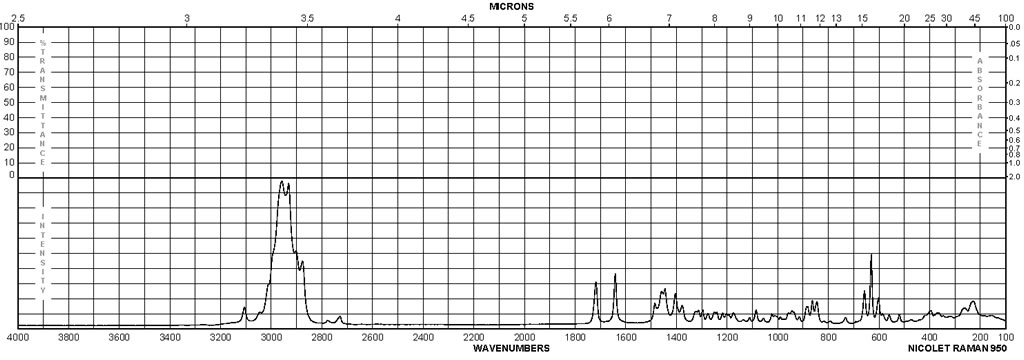Isobornyl methacrylate CAS#: 7534-94-3; ChemWhat Code: 57515
Identification
| Product Name | Isobornyl methacrylate |
| IUPAC Name | [(1R,2R,4R)-1,7,7-trimethyl-2-bicyclo[2.2.1]heptanyl] 2-methylprop-2-enoate |
| Molecular Structure |  |
| CAS Registry Number | 7534-94-3 |
| EINECS Number | 231-403-1 |
| MDL Number | MFCD00081070 |
| Synonyms | (1R,2R,4R)-1,7,7-trimethylbicyclo[2.2.1]hept-2-yl 2-methylprop-2-enoate;(1R,2R,4S)-1,7,7-Trimethylbicyclo[2.2.1]hept-2-ylmethacrylat; IBMA |
| Molecular Formula | C14H22O2 |
| Molecular Weight | 222.32 |
| InChI | InChI=1S/C14H22O2/c1-9(2)12(15)16-11-8-10-6-7-14(11,5)13(10,3)4/h10-11H,1,6-8H2,2-5H3/t10-,11+,14-/m0/s1 |
| InChI Key | IAXXETNIOYFMLW-GYSYKLTISA-N |
| Canonical SMILES | CC(=C)C(=O)OC1CC2CCC1(C2(C)C)C |
| Isomeric SMILES | CC(=C)C(=O)O[C@@H]1C[C@H]2CC[C@@]1(C2(C)C)C |
| Patent Information | ||
| Patent ID | Title | Publication Date |
| US5154920 | Disinfectant polymeric coatings for hard surfaces | 1992 |
| EP194770 | Disinfectant polymeric coatings for hard surfaces | 1991 |
Physical Data
| Appearance | Colorless transparent clear liquid |
| Water Solubility | Slightly soluble(1.87e-02 g/L) |
| Melting Point | -60 °C |
| Boiling Point | 127-129 °C15 mm Hg(lit.) |
| Flash Point | 225 °F |
| Refractive index | n20/D 1.477(lit.) |
| Water Solubility | negligible |
| Density | 0.983 g/mL at 25 °C(lit.) |
Spectra
| Description (NMR Spectroscopy) | Nucleus (NMR Spectroscopy) | Solvents (NMR Spectroscopy) | Frequency (NMR Spectroscopy), MHz |
| Chemical shifts | 1H | chloroform-d1 | 400 |
| Chemical shifts | 13C | chloroform-d1 | 400 |
| Description (IR Spectroscopy) | Solvent (IR Spectroscopy) |
| Bands | neat liquid |
| Description (Mass Spectroscopy) | Solvent (UV/VIS Spectroscopy) | Comment (UV/VIS Spectroscopy) |
| fast atom bombardment (FAB), high resolution mass spectrometry (HRMS), spectrum |
Route of Synthesis (ROS)

| Conditions | Yield |
| With acetic acid In methanol; cyclohexane Experimental Procedure Comparative Example 1 Isobornyl Methacrylate without Lithium Bromide A 3-L 4-necked round-bottomed flask equipped with a mechanical stirrer, air sparge (10-15 mL/min), thermocouple, 12-inch column (packed with 0.20 inch Propak packing, approximately 6 plates), and variable reflux head is charged with 588 g (3 moles) of isobornyl acetate, cyclohexane (300 g), and methyl methacrylate (450 g, 4.5 moles). The reaction mixture is brought to reflux and about 10 mL of cyclohexane/H2 O is distilled out over approximately 15 minutes. A solution of 10percent lithium t-butoxide in cyclohexane (40 g, 0.05 moles) is added and the reaction placed under total reflux until the head temperature drops to 57° C. The cyclohexane/methyl acetate azeotrope is removed at a reflux ratio of 9:1. The head temperature remains at 57° C. for the first two-thirds of the reaction and then slowly rises to 70° C. at the conclusion while the pot temperature rises to about 105-110° C. The reaction is continued until the ratio of isobornyl methacrylate to isobornyl acetate exceeds 100. Once the reaction is complete, the batch is cooled to 80° C. and acetic acid (5.4 g, 0.09 moles) is added. The remaining cyclohexane and methyl methacrylate are removed via vacuum distillation (70-80° C.). When the crude product is dissolved in (2/98 vol/vol) in methanol, a cloudy white precipitate forms. The crude product is diluted with an equal weight of cyclohexane and washed with 20percent by weight of 20percent caustic. The two phases do not separate on prolonged standing. This result as well as the large quantity of precipitate produced on dissolving the crude reaction mixture in methanol indicate the presence of polymer in the reaction mixture. |
Safety and Hazards
| Pictogram(s) |   |
| Signal | Warning |
| GHS Hazard Statements | H315: Causes skin irritation [Warning Skin corrosion/irritation] H319: Causes serious eye irritation [Warning Serious eye damage/eye irritation] H335: May cause respiratory irritation [Warning Specific target organ toxicity, single exposure; Respiratory tract irritation] H411: Toxic to aquatic life with long lasting effects [Hazardous to the aquatic environment, long-term hazard] H412: Harmful to aquatic life with long lasting effects [Hazardous to the aquatic environment, long-term hazard] Information may vary between notifications depending on impurities, additives, and other factors. |
| Precautionary Statement Codes | P261, P264, P271, P273, P280, P302+P352, P304+P340, P305+P351+P338, P312, P321, P332+P313, P337+P313, P362, P391, P403+P233, P405, and P501 (The corresponding statement to each P-code can be found at the GHS Classification page.) |
Other Data
| Transportation | Not dangerous goods |
| Under the room temperature and away from light | |
| HS Code | 294200 |
| Storage | Under the room temperature and away from light |
| Shelf Life | 2 years |
| Market Price |
| Use Pattern |
| IBOMA is a special monomer with many func-tions. |
| IBOMA can effectively reduce the viscosity of polymer solution |
| IBOMA is more effective to reduce the viscosity of polymer solutions. |
| Acrylic resin added IBOMA is soluble in polyester, alkyd and film-forming materials of many volatile paints. |
Buy Reagent | |
| No reagent supplier? | Send quick inquiry to ChemWhat |
| Want to be listed here as a reagent supplier? (Paid service) | Click here to contact ChemWhat |
Approved Manufacturers | |
| Warshel Chemical Ltd | http://www.warshel.com/ |
| Want to be listed as an approved manufacturer (Requires approvement)? | Please download and fill out this form and send back to approved-manufacturers@chemwhat.com |
Contact Us for Other Help | |
| Contact us for other information or services | Click here to contact ChemWhat |


